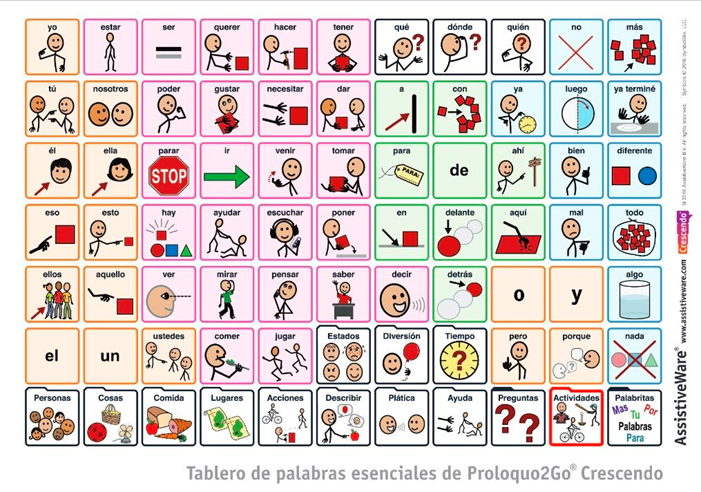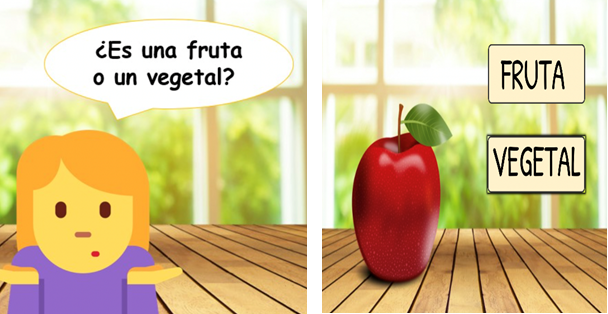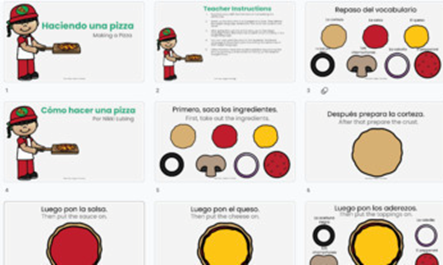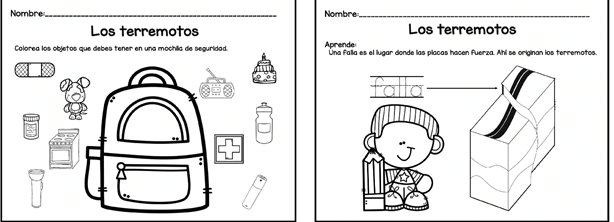Un/Una (A/One)
WAYS WE CAN USE THE WORD(S)
REQUEST: Quiero una paleta. (I want a lollipop.)
ANSWER QUESTIONS: Una jirafa. (A giraffe.)
GAIN ATTENTION: Mira, una mariposa! (Look, a butterfly!)
SHARE INFORMATION: Yo tengo tres gatos y un perro. (I have three cats and one dog.)
GET HELP: Necesito un tenedor. (I need a fork.)
PRETEND: Soy un principe. (I am a prince.)
CONJUGATIONS FOR GENDER AND NUMBER
|
SINGULAR |
PLURAL |
|
un/una |
unos/unas |
For specific questions or more ideas regarding this core word activity sheet, please contact Maryvi Morales @ marygm12@gmail.com. Thank you!
Snack/mealtimes: During mealtime students might need certain utensils to eat their meals. Students can use ‘un/una’ to identify what utensil or item they need. The student can say, e.g., “Necesito un tenedor y una servilleta” (I need a fork and a napkin”).
During snack, students can share with adults and their peers, what they have brought to eat e.g., “Una torta, un sandwich, un platano” (a torta, a sandwich, a banana).
Circle: During circle time, students can use ‘un/una’ to answer questions at circle time or share what they did over the weekend with their family e.g., “Es un pinguino” o “Hicimos un pastel de chocolate” (“It’s a penguin” or “We made a chocolate cake”).
Show and tell: Students can bring a special picture or item to class to show during circle time and share information. Students can use “un/una” to tell their classmates what is the item or picture they brought e.g. “Es un collar que me regalo mi papá” or “Aqui estoy en un crucero” (“It’s a necklace that my dad gave me” or “Here I am on a cruise").
Guessing Game: Students can use ‘un/una’ during a guessing game when providing hints to their classmates about what they are. For example, if they are trying to have their classmate guess that they are a giraffe the student can say e.g., “Soy un animal. Soy un mamífero alto. Tengo un cuello largo. quién soy? ---Soy una jirafa!” (I am an animal. I am a tall mammal. I have a long neck. Who am I?--- I am a giraffe!)
Pretend play: Students can use ‘un/una’ to pretend to be anything they would like “Soy un dinosario! RAWR” or “Soy un doctor y te voy curar.”
Telephone game: Adults can model using ‘un/una’ when explaining the rules of a game, in this case telephone but it can be any game. Adults can say
“Ok, necesitamos formar un circulo, vamos a escoger una persona que piense en una oracion y luego se le va susurrar a su compañero a la izquierda....”
Here are some suggested books on YouTube that can assist in teaching the core words:
- Si Le Das Una Galleta a un Ratón: By Laura Numeroff | Children's book read aloud |Teacher Toast
- Veo un círculo: By Quilean Croi| Unite for Literacy
- Encuentra un fósil: By Holly Hartman |Unite for Literacy
- Una mascota secreta: By Holly Hartman and Nina Ollikainen |Unite for literacy
- Estamos en un libro: By Mo Willems | Childrens book read aloud| Tiempo de leer
- Un tipo grande se llevó mi pelota! By Mo Willems | Childrens book read alout |Tiempo de leer
- Así es mi corazón: By Jo Witek and Christine Roussey |Childrens book read aloud | Cuéntame un cuento
- La oruga muy hambrienta: By Eric Carle|Children’s book read aloud |Cuentilandia
- Qué hay dentro? Qué hay debajo? By: Vv.Aa|Children’s book read aloud |Cuéntame un cuento
Students can use ‘un/una’ when answering questions from peers, sharing information about themselves with peers, or instructing their peers during a game e.g., “Es un juguete” or “Toque una jirafa en el zoológico” or “Necesitas una pluma”
Here is a sample communication board that provides access to ‘un’:

Another idea is to have students take turns looking in the mirror and indicating, e.g., “Yo soy un niño y tu eres una niña.” Of course, keep in mind, this may not be appropriate depending on students’ pronouns/how they identify.
During motor activities, students can follow a recipe and learn how to make a cake. Adults can model ‘un/una’ by instructing them what comes next in the recipe e.g., “Primero necesitamos que prender el horno para que se caliente. Luego vamos a necesitar un huevo, una cucharilla de vainilla, una taza de azucar...”
Students can be blindfolded/close their eyes and smell, touch, and taste (if applicable) a number of different items and try guessing what they might be. For example, an adult might hold a piece of an orange to the student's nose and have them smell it, touch it and ask the student “que es?” (What is it?) “platano” (banana) and model “Si es un platano” (Yes, it's a banana).

Category activity: Students can be introduced different fruits and vegetables, and have them individually or take turns identifying if it is a fruit or vegetable. Adults can model “La manzana, es una fruta o un vegetal?.....Si muy bien, es una fruta!” (Is the apple a fruit or a vegetable?....Yes good job it's a fruit!)

Sequencing activity: Students can learn about sequencing by choosing something they would like to write the steps to. For example, they might enjoy making pizza with their mom so their story would say “Como hacer una pizza”, another student might enjoy baking cakes with their sibling “Como hacer un pastel de vainilla”. The adult can emphasize and model the word ‘un/una’ through this activity.

Mad libs activity: Adults can model the words ‘un/una’ as well as other vocabulary through a mad libs activity. For example, in “Una Misión Espantosa: El costo de amor,” each student can create their own story, and the activity provides examples on how they can fill out the story and adults can support them.


- Un Poco Loco (De “Coco”)| Canciones Infantiles |DisneyMusicLaVEVO
- Tengo Una Mascota | Canciones Infantiles | Super Simple Español
- Soy una serpiente |Canciones Infantiles | El Reino Infantil
- La Hormiguita |Canciones Infantiles | ChiquitinesTV
- Pin Pon es un Muñeco | Canciones infantiles | toycantando
- Soy una Taza | Canciones Infantiles |Chiquitines
- Una vez me Encontré |Canciones Infantiles |ChiquitinesTV
- Un Barquito | Canciones Infantiles | ChiquitinesTV
- Yo Tengo una Muñeca | Canciones infantiles |ChiquitinesTV
Science Activity: Students will learn about earthquakes. Adults will model ‘un/una’ by asking and explaining what a fault is, and asking students what items they should carry in a safety backpack for an earthquake. “Que es una falla?” (What is a fault?) or “Que debes de tener en una mochila de seguridad?” (What should you have in a safety backpack?)

Art Activity: Students can draw, paint, or create an item with construction paper or any other arts and crafts materials they may have access to in the class to create something unique to them. When their artwork is done, they can each share or they can also have their friends guess what it is e.g., “Es un arcoiris” or “Si, es un arbol!”

WORD WALL- Add the word Un, Una on the Word Wall.
Tarheel Reader: Students can use Tarheel Reader to write books about different characteristics of an animal using the word ‘un/una.’ These books can be shared with other peers and read aloud during class.
READING and the Word Wall: Sound out the letters together. Have the students find the word on the AAC system.
WRITING and the Word Wall: Using a pencil or alternative pencil, have students try to type the word on the keyboard, adapted keyboard or write the word together.